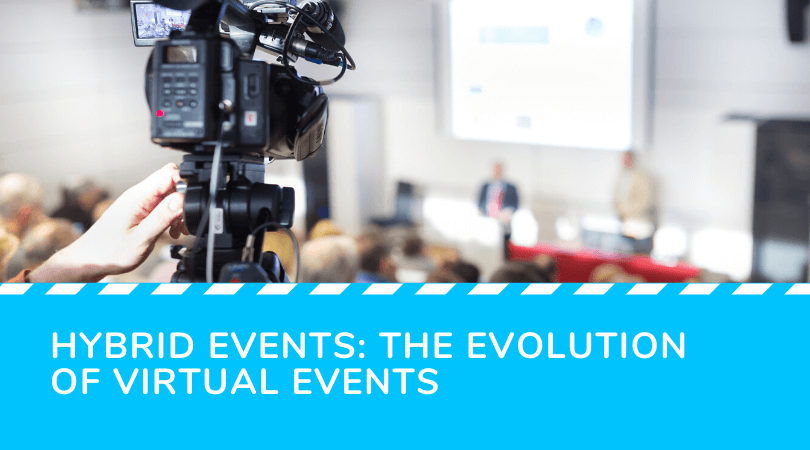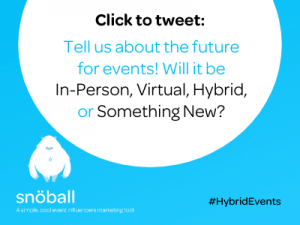As the world keeps turning and official pandemic restrictions are rolled back, events will see a return to normal…or whatever normal means for us now. The truth is things are going to be different than they were before COVID-19, at least for a while. Nobody really knows how long it will take for people and businesses to feel comfortable with standard travel, major gatherings or even a return to the office.
But events are coming back. With a trillion dollar industry footprint, there’s simply too many incentives to outright cancel events. And it’s not just the economic and social impact, it’s human nature that people crave contact with people. We’re in the business of connecting individuals and organizations because they want to connect.
PCMA cites a Global DMC Partners survey that states “64 percent of [event planners] predicted they will host a live event between August 2020 and January 2021” and “63 percent of survey respondents had no plans for their 2021 events to be completely virtual.” To reiterate, more than half of event planners surveyed are planning some form of in-person component to their events over the next six months.
Hey there #EventProfs! We want to hear from you!
How do you think most events will look for the next 18 months? Let us know in the poll below! #Expochat #virtualevents #eventsindustry #conferenceplanners #meetingplanners #hybridevents
— snöball (@snoballevent) July 8, 2020
Hybrid Events as a Long-Term Strategy
The reality is virtual events are here to stay, at least for now. Just because the MLB and NBA are restarting their seasons (with heavy restrictions), does not mean that normal events are in the same boat. In the world of B2B events, most companies are still restricting non-essential travel. It’s going to be hard to fill up an exhibition hall with exhibitors and attendees without corporate buy-in.
And it’s not just the challenge of travel restrictions. The ROI for in-person events is uncertain. Investing your marketing team’s time and money into an event that might be cancelled, postponed or just not well attended isn’t feasible in our economic climate. Social distancing is still a real phenomenon. Restaurants (where they’re open) are operating at half capacity and plenty of people are still hunkered down at home. We’re just not quite to a point that fully in-person events are possible.
But, there’s hope! Just because we can’t host our typical live events at the moment doesn’t mean we shouldn’t start looking to the future. We’re going to see smaller live audiences at smaller, niche, more widespread events. Increased accessibility and attendance at those events will depend on a strong digital delivery. Hybrid events that enable a digital audience to engage with the live event are the next step. Events are transforming into a blended experience and that experience is here to stay.
Post-covid, post-vaccine. Business events should remain people-centric and purpose-driven. Know WHY you are meeting, WHO you want there and WHAT you want to achieve then set the space and time to suit this. This could mean the ‘right’ furniture, lighting and minimal background noise for meaningful connections and dialogue, or a plant-based dining experience where sustainability thinking is embraced – there won’t be one right solution but with the right choices, we can increase the impact of every interaction. Let’s do that. – Tahira Endean, Head of Events, SITE
Planning for Hybrid Starts Now
A purely virtual event is a temporary solution, it was never meant to be an outright replacement.
I think the future of events is flexible and that change will continue to happen at the speed of light. I see us producing virtual and hybrid events for at least the next 2 years, which means eventprofs should invest in the resources (people and tech stack) that will allow them to succeed no matter what the world is throwing at us. This means thinking creatively about the way we’ve always done things and bringing those critical elements of human connection in as many ways as possible. – Lindsay Martin-Bilbrey, CEO, Nifty Method
People crave human-to-human contact. Watching a webinar will never be the same experience as sitting in a session and we shouldn’t expect it to be. The engagement that develops during a live session is authentic – people’s voices are actually heard, the audience can see one another, the experience surrounds the audience.
And the ability to meet directly with an expert or shake a new colleague’s hand is irreplaceable. It resonates with something very human inside all of us – the social side of being people. When we meet people at events or attend educational sessions, we feel real connections. Our learning is deeper. We have fun.
And that’s the underlying reason hybrid events are here to stay. They inspire connections that a virtual event simply can’t do on it’s own. Hybrid events are trailblazing a new event normal to tackle the challenges presented by our new societal normal.
Live events will bounce back but nothing like we have seen them before. Our landscape was forced to change quicker than we had anticipated but it was always a change of which would have eventually occurred. Virtual is here to stay and many have see. The value behind it. This means organizers will need to produce hybrid events in which both the virtual and live worlds are connected. We have entered a new era of hybrid that I think is only going to soar our industry into new heights – Bill McGlade, CEO, Victory Productions
Virtual Communities, Real Connections
Let’s go straight after the elephant in the room: How do hybrid events actually differentiate themselves from virtual events?
From a technology point of view, hybrid events and virtual events are two sides of the same coin. The digital content delivery is key to both experiences. But, the main difference will be how the technology is used by the audience to interact with the live component. Hybrid events will create communities within their virtual audience, which fuel the connections like those at in-person events.
Here’s an example of an effective hybrid approach: Twitch video game streaming. Twitch is an excellent example of how a virtual audience is capable of directly interacting with a live performer. Watch some of the top streamers and you’ll see a community in their live chat, along with two-way communication from the streamer to the viewers. It creates a connection between the virtual audience and the streamer that we would normally only see in face-to-face interactions.
Twitch isn’t exactly revolutionary technology – it’s a live chat alongside a video stream. But, the way it was deployed allowed for communities to easily mobilize.
Strategies to Hybridize your Community
Successful hybrid events will be the ones that create communities. Since live events have been historically successful in building engaging and vibrant in-person communities, let’s take a quick look at a few strategies to develop your virtual community too:
Keep your virtual attendees involved: It seems obvious, but make sure your virtual attendees are heard! Pause your live presentations to give a voice to the remote audience – put out a poll, Zoom an audience member in, read live tweets during your sessions. All of these things will keep your virtual audience from feeling left out.
Host Virtual Happy Hours for Session Speakers: Each speaker should be encouraged to host a virtual happy hour or Q&A session over video chat. One of the biggest differentiators between a webinar and a session is the post-event engagement – give your virtual audience the same chance to connect!
Create Virtual Event Moderators: Keeping the digital conversation alive is key. Virtual participants want to engage with other attendees, but sometimes virtual discussion is tough to start. Virtual event moderators help direct topics and re-engage individuals.
Don’t Rush The Show: Give your virtual attendees a chance to respond and engage. It’s easy to move too quickly and miss out on an opportunity to connect with your virtual attendees. Make sure you find clever ways to fill time while you wait for your virtual audience – you won’t want to disengage your live audience with a major stoppage!
Incorporate Video Streaming: We all know a conference call is more personal when we’re on video. It’s no different for a virtual event. Create smaller sessions, activities and presentations where virtual attendees can be seen by one another. Bonus points if your activity involves your live audience too!
I think we’re going to see that virtual is no longer an afterthought, but a primary part of our event strategy. We are just now really pushing the boundaries of the tech for virtual & hybrid events so I’m excited to see how platforms evolve to create more engaging and inclusive virtual experiences that will power virtual & hybrid into the future! – Liz Caruso, CEO, techsytalk
Bottom Line
Live events are still a ways away. But in the meantime, let’s reimagine and reinvent events that create closer and more engaged communities. Let’s consider how hybrid events can create the communities that will fuel our new event normal.
A purely virtual event is a temporary solution, it was never meant to be an outright replacement. – Rachel Stephan, snöballer-in-chief, snöball
The most visionary meeting planners and show organizers are investing in the long term game. How do you see the future of events – is it virtual, in-person, hybrid or something we haven’t even considered? Let us know on Twitter – we’d love to hear your thoughts!


